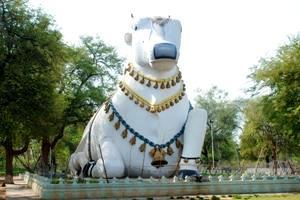Rasa Siddha is said to have built the Vimana and for wages he made the workers set up sand mounds, which he converted into wealth by his power. Proof of this is seen on the main gate of the temple facing the west. A copper plate by Krishandevaraya states that Mahanandi is one of the sacred  places where the king`s brother Simha Deva Raya gave valuable gifts. The Sthalapurana states that Nanda ruled over Navanandis where Mahanandi is situated. The king once thought to anoint the idol and perform abhishek with milk. Herds of cows were brought in which included a black cow. This cow gave a lot of milk and was allowed to travel freely and graze in the forest.
places where the king`s brother Simha Deva Raya gave valuable gifts. The Sthalapurana states that Nanda ruled over Navanandis where Mahanandi is situated. The king once thought to anoint the idol and perform abhishek with milk. Herds of cows were brought in which included a black cow. This cow gave a lot of milk and was allowed to travel freely and graze in the forest.
The cow always seemed to take far longer in the forest than usual and the milk supply seemed depleted when she returned. One day a cowherd followed the cow and found her grazing around an anthill and then she stood right over it letting the milk flow over the anthill. From it a young child emerged said to be Lord Krishna, after which the cow returned. The next day the king followed the cow and, hid in a bush expecting to catch a glimpse of the Lord. The cow arrived and circled the anthill, Krishna appeared and accepted the offering. The king in surprise moved forward, scaring the nervous cow, who stepped on the anthill in fright. The child disappeared, the hoof print remained on the anthill. The king realizing his mistake prayed for forgiveness and the Lord ordained the anthill after it dried would become a Swayambhu linga at Mahanandi. The two signs are still visible on top of the Linga.
Architecture: The temple is at the foothill where a mineral spring flows into the fields from underneath the linga, into the tank in front of the temple. The temple is surrounded by mantapas on all sides. The Vimana over the sanctum is in Nagari style. It has a Shikara at the top. The architectural peculiarities show that the temple dates back to ancient times and it was repaired and rebuilt through the ages by many kings. This temple is famous for its curative powers found in the warm tepid mineral water found in the tank in front of the temple. It is a sixty feet square with a mantapa in the centre. The inlets and outlets of the tank are so arranged that the depth of the water remains constant at five feet for the devotees to swim in. The source of this water has never been traced. The water is said to come from five springs called Srisailadhara, Narasimhadhara, Daivodhinidhara, Nanditirtha and Kailasatirtha.
The sanctum contains a linga and is made from a rough uncut rock, with two sockets. Here the linga is seen just above the earth`s surface without the three Peethams underneath. All can touch and worship the Lord. A huge Nandi is at the front of the shrine and hence it is called Mahanandi Tirtha. The tank that lies behind is known as Rudra gundam and there are two more tanks called Vishnu gundam and Brahma gundam. Close to the main shrine is a shrine dedicated to the Goddess. The Srichakra in front of the deity is said to have been installed by Adisankara himself. The popular belief is that if one meditates upon the God then he will receive a darshan befitting his status in front of the mother. The mukhamantapa of the goddess is a recent construction.
Behind the main shrine there are three small shrines containing a Shivalinga each. It is stated that if these are worshipped, they will take one beyond the Sthoola, Sookshma and Karana Dehas to the Turiya stage. Within ten miles of Mahanandi there are other nine other Nandi temples
1. Padma Nandi
2. Naga Nandi
3. Vinayaka Nandi
4. Garuda Nandi
5. Brahma Nandi
6. Surya Nandi
7. Vishnu Nandi
8. Soma Nandi
9. Siva Nandi